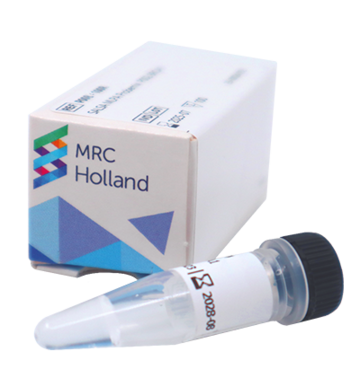Hearing loss is a common congenital defect. The estimated incidence of permanent hearing loss at birth, defined as a sensorineural loss of ≥35 dB, is 1 in 500-1000 newborns, and approximately 50 to 60% of all hearing loss cases have been attributed to inherited or genetic factors. Inheritance of hearing loss can be autosomal recessive (75-85%), autosomal dominant (15-24%), X-linked (1-2%) or mitochondrial. More than 70% of hereditary hearing loss is nonsyndromic; the remaining 30% is accompanied by additional clinical findings and is considered syndromic.
In many populations, up to 50% of all cases of autosomal recessive nonsyndromic hearing loss are caused by mutations in the DFNB1 (Deafness, Nonsyndromic, autosomal recessive 1) locus on 13q12 (https://www.ncbi.nlm.nih.gov/books/NBK1272/). This locus contains the GJB2 and GJB6 genes, encoding connexin 26 and 30 protein, respectively. In Caucasians, the GJB2 c.35delG is the most frequent mutation, comprising 70% of mutated DFNB1 alleles with a carrier rate of 2–4% in the northern European population. The c.235delC mutation is the most common variant in the Japanese population (carrier rate of 1-2%). With a carrier rate of ~7.5%, the c.167delT mutation is the most frequently occurring mutation in the Ashkenazi Jewish population. The c.101T>C mutation is associated with mild hearing loss and has a minor allele frequency of 1-2%. The IVS1+1G>A and c.313del14 mutations have been found with relatively high frequency among various populations, mainly in eastern Europe, Russia, the Middle East and Asia. Six large deletions in GJB2 and/or GJB6 have been shown to contribute to DFNB1 hearing loss and account for 1–10% of all the mutated DFNB1 alleles. The most common deletions of 309 kilobases (kb) [del(GJB6-D13S1830)] and 232 kb [del(GJB6-D13S1854)] truncate GJB6 and the upstream CRYL1 gene.
GJB3 is located on 1p34, which is the DFNA2B (Deafness, Nonsyndromic, autosomal dominant 2B) locus. Mutations in GJB3 can cause nonsyndromic hearing loss, as well as the skin disorder erythrokeratodermia variabilis (https://www.ncbi.nlm.nih.gov/books/NBK1434/).
The GJB2 and GJB6 genes are also involved in DFNA3 (Deafness, Nonsyndromic, autosomal dominant 3). DFNA3 is caused by a heterozygous pathogenic mutation in one of the two genes. The relative prevalence of DFNA3 as a cause of autosomal dominant nonsyndromic hearing loss is not known, but it is extremely rare; only 14 pathogenic variants have been described worldwide. The majority of these pathogenic variants are described only in single families or simplex cases. Copy number changes in GJB2 and GJB6 related to DFNA3 have not been described (https://www.ncbi.nlm.nih.gov/books/NBK1536/).
About half of all X-linked hearing loss cases are caused by pathogenic mutations in the POU3F4 gene and upstream region of the gene. Several X-linked hearing loss patients and families possess deletions that do not affect the transcribed region of POU3F4, but instead remove different portions of DNA upstream of POU3F4 where putative regulatory elements reside. POU3F4 is located on the X chromosome, in a 3-Mb gene desert region enriched for highly conserved non-coding regions (HCNRs). Multiple enhancers, important for POU3F4 expression, are defined within these HCNRs at 970, 920, 170 and 12 kb upstream of POU3F4 (Naranjo et al. 2010, Song et al. 2010, Vore et al. 2005).
Wolfram Syndrome is a progressive neurodegenerative disorder characterised by the onset of diabetes mellitus and optic atrophy before the age of 15 and is typically associated with sensorineural hearing loss, progressive neurologic abnormalities, and other endocrine abnormalities. The estimated prevalence of Wolfram Syndrome type 1 is 1 in 500,000 people worldwide. Mutations in WFS1 cause more than 90% of Wolfram Syndrome type 1 cases (https://www.ncbi.nlm.nih.gov/books/NBK4144/).





